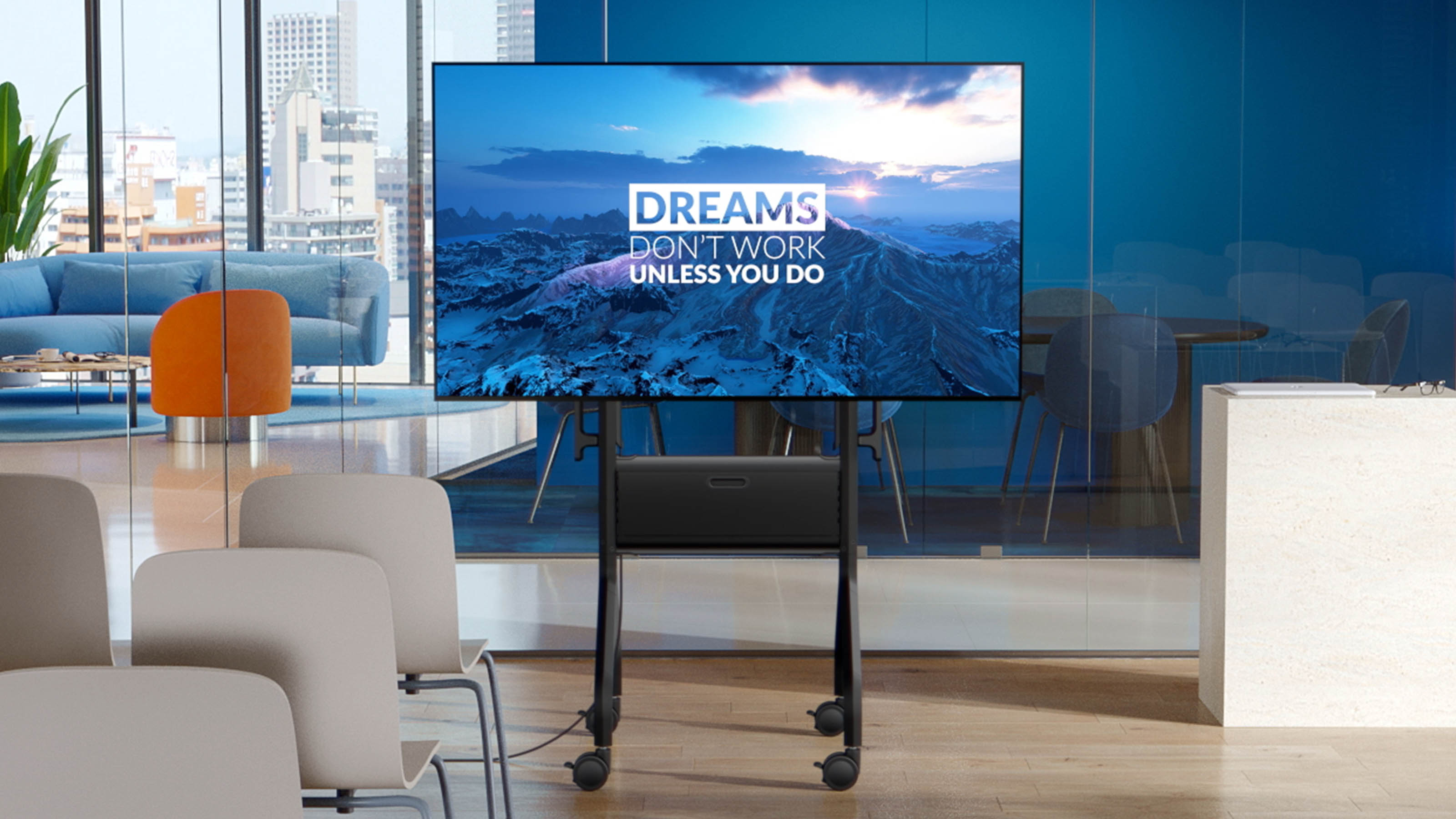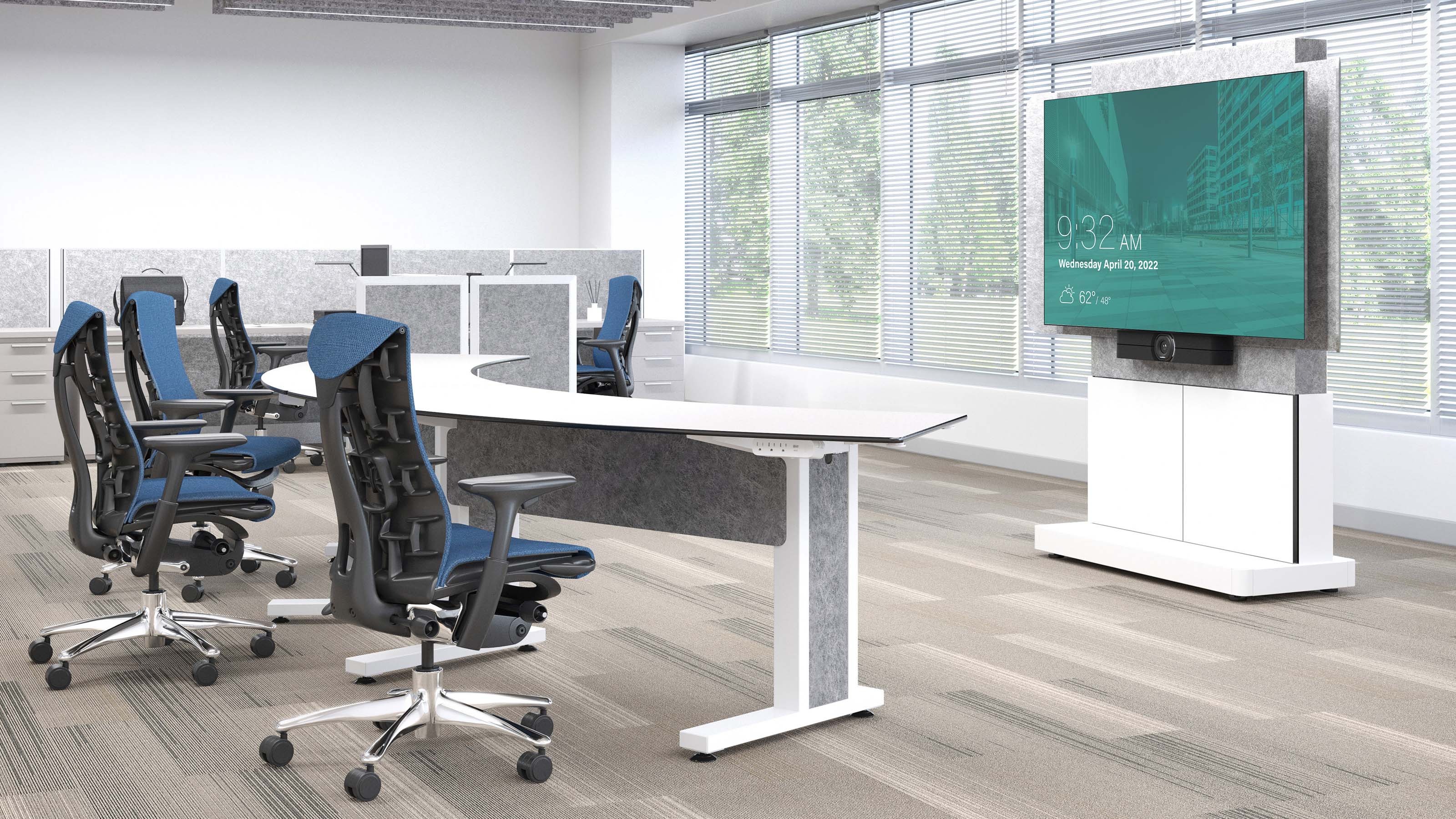Thank You for Your Support
Experts share some of today's video display mounting trends.

Video displays are central to today’s AV-enabled workplace. But providing the most useful experience to their users, including those in remote locations, requires the right mix of supporting equipment, all of which play a role in today’s video display mounting systems.

The biggest trend in video display mounting systems today is the use of "supporting players," those pieces of technology that maximize the experiences delivered by these screens. “Whether for a bring-your-own-device [BYOD] environment, or a native Microsoft Teams Room or Zoom Room, there is typically a number of key AV components that need to be housed within the room,” said David Albright, business development manager at Legrand|AV.
[The Integration Guide to Video Displays and Mounts]
These components can include docking stations and/or extension systems, room PCs, network switches, and amplifiers, plus intelligent power solutions to protect the equipment from power surges. “Mounting and storage systems—whether wall-mounted, floor-to-wall systems, freestanding, or mobile solutions—all must flexibly support this essential equipment,” he said. “Cable management is also important to consider, as often cables need to be run from the wall to a freestanding table in the room. Floor raceway solutions that complement the AV system and furniture are incredibly valuable to ensure a robust and attractive design.”
The good news: “Wall, ceiling, stand, cart, enclosures, and freestanding kiosk mounting applications exist for projectors and dvLED fixed display walls for indoor and outdoor environments in custom orientations,” said John Wills, Exertis Almo Pro AV’s director of business development. So do all-in-one videoconferencing bars that include the necessary cameras, microphones, and speakers to work with the video displays.

“To support the many different brands of these that are available on the market, B-Tech has produced a series of videobar mounts, which can be mounted to the wall or to all of our different carts and stands,” said Nick Spencer, director of marketing and communications at B-Tech AV Mounts. “These feature multiple fixing points so that a single mount can be used to mount multiple different brands, such as our BT7871, which fits Poly, Neat, Bose, and Jabra products.”
Quality and Safety Concerns
A second trend in video display mounting systems is an emphasis on robust, high-quality systems, especially those whose levels of quality and safety have been certified by respected third parties.
A daily selection of the top stories for AV integrators, resellers and consultants. Sign up below.
“Choosing a reputable mounting brand with a long history in the business is the best way to guarantee a positive experience for both integrator and the end user,” said Spencer. “Opting for a cheaper brand might not equate to a cost saving in the long run; those products are usually cheaper for a reason, and those reasons do not normally align with a good user experience or longevity.”

Granted, systems that meet safety certification standards such as those set out by UL Solutions (UL) are more expensive than non-certified systems. “There's always a price to be tested, certified, and listed,” Wills explained.
[Smith Transitions to Distribution with Exertis Almo]
According to Albright, the extra expense is worth it. “UL-listed display mount products have been tested to meet or exceed UL's rigorous requirements for weight capacity, tip safety, and other concerns, so you're sure to provide your client with a safe product,” he said.
Ease and speed of the install are also important. “Robust commercial display mounts, like Chief's Fusion series, have a variety of features specifically intended to reduce valuable installation time," Albright added. "Serviceability of the install is important—choosing solutions with options for AV component storage, in-wall storage boxes with integrated power, and robust cable management all are valuable for AV integrators.”
Preparation Counts

When it comes to installing/servicing video display mounting systems, smart integrators are "scoping out" the spaces first to do the job right. A number of factors have to be considered in order to choose the most appropriate mounting systems and where/how to mount them. “Weight, VESA mounting patterns, distance from viewers, outdoor wind rating [if applicable], security, ADA compliance, and special digital signage configurations are some of the many factors to be considered when designing the correct solution,” Wills said.
“If construction mode is unknown, or speed and simplicity of installation is of consideration, floor-to-wall mount and freestanding and mobile options, such as Middle Atlantic’s Forum Display Stand and Chief’s new Voyager Cart, are great alternatives, as they eliminate the need for a structural wall,” Albright added. “In bright spaces where there is high ambient light, high-brightness displays or Parallax ambient light rejecting screen surfaces are both great options. Additionally, while projector manufacturers are working on higher resolution solutions, Da-Lite's HD Progressive screen surfaces are 16K ready.”
Having this knowledge upfront allows customers and integrators to make the best equipment choices, particularly when space is tight. “Mounting solutions with integrated storage for AV equipment such as mini-PCs, screen sharing devices, or video codecs have been a particular highlight of our product range during the past year, with our BT7883 and BT7885 AV storage solutions providing slide-out trays for easy access to equipment that is behind the mounted display,” said Spencer.
The Move to Movable
Cost-conscious businesses are looking for ways to do more for less, such as sharing videoconferencing systems between two or more rooms. “Portability is a big requirement in today's conferencing and collaboration configurations,” said Wills. “Carts of various sizes, both manual and powered, are part of our solutions.”

“Chief and Middle Atlantic both have seen growth in demand for our families of mobile and freestanding display mounting solutions in support of this trend,” Albright noted. “Chief's new Voyager Mobile AV Cart is a stylish and robust mobile display stand that complements architectural spaces while providing flexible AV mounting and component storage needs for mobile Microsoft Teams Room and Zoom Room systems.”
“All of B-Tech’s display mounting solutions can be accessorized with our full range of shelves or the aforementioned videobar mounts to create complete mobile UC/VC solutions,” said Spencer. “For example, our BT8562 ‘designer cart’ has a high-end aesthetic, which is ideal for corporate applications, and our BT7871 mounting plate can be added to the solution using just four screws, allowing a range of different videobars to be fitted.”
dvLED Popularity
A final video mounting display system trend to consider is the growing popularity of dvLED. These displays lack the usual LCD panels, using surface arrays of LEDs to deliver wider contrast and more vivid colors to viewers.
[Why dvLED Is Gaining Market Share]
“dvLED technology is being used more frequently, and display manufacturers are now using their dvLED cabinets to create large ‘all-in-one’ displays,” Spencer said. “We have already adapted our mounting systems to be able to quickly launch suitable mounting solutions for brands such as LG and Samsung.”
The downside: The ultra-high quality of dvLED displays mean that any flaws in mounting them will stand out to viewers. “dvLED is probably one of the more sophisticated and exacting specs that mounting solutions have to meet,” admitted Wills. “Your adjustments once the displays are mounted have to be perfect, because that’s what people expect.”
The quality of dvLED displays make this format ideal for widescreen 21:9 video walls. “Although 21:9 displays are currently all standard LED displays, we expect to see further growth in ultrawide format display solutions, with more manufacturers bringing new 21:9 aspect ratio displays, projectors, and screens to market,” Albright said. “Chief and Da-Lite both are ready to support the growth of ultrawide format content, as it lends to enhanced screen real estate that elevates meeting equity in hybrid conferencing and collaboration environments."
James Careless is an award-winning freelance journalist with extensive experience in audio-visual equipment, AV system design, and AV integration. His credits include numerous articles for Systems Contractor News, AV Technology, Radio World, and TV Tech, among others. Careless comes from a broadcasting background, with credits at CBC Radio, NPR, and NBC News. He currently co-produces/co-hosts the CDR Radio podcast, which covers the Canadian defense industry. Careless is a two-time winner of the PBI Media Award for Excellence.

